the history of yeovil's pubs
PUBS HOME PAGE |
PUBS INTRODUCTION |
PUBS BY NAME |
BEERHOUSES |
butcher's arms
7 Hendford
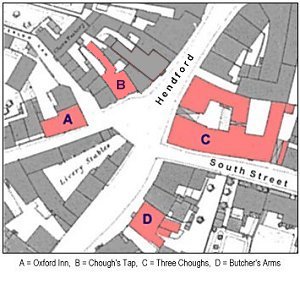 The
Butcher's Arms
(marked 'D' on
the map) is a
difficult
building to
date, especially
inside, but it
appears to be a
lot younger than
you would
probably think.
The
Butcher's Arms
(marked 'D' on
the map) is a
difficult
building to
date, especially
inside, but it
appears to be a
lot younger than
you would
probably think.
The front elevation, to Hendford, is of pleasing proportions constructed of ashlar with stone mullioned windows with hood mouldings, under a Welsh slate roof. The off-centre entrance is set within a Ham stone surround with a very low four-centred arch and a hood moulding over.
The 1846 Tithe Apportionment noted that Parcel 371, comprising the whole of the properties on the corner at the junction of Hendford and South Street including the Butcher's Arms, was owned by glove manufacturer William Hooper Masters of South Street House, just a couple of doors away, and the occupier was George Raymond who was listed as a beer retailer and brewer in several local trade directories.
In the 1861 census John Slade, is described as a butcher and beerhouse keeper, so it's not a huge leap of imagination to think that he named the pub after his own profession.
In 1875 and 1878 the Post Office Directory noted that C Pitcher ran a carrier service to Milborne Port from the Butchers Arms every Tuesday and Friday. By 1879 the Milborne Port service was being run from the George by Mr Collins while Mr Hockey was doing a Middle Chinnock run 'nearly every day' from the Butchers Arms, continuing in 1880 and 1882.
Interestingly, the 1885 advertisement placed in Whitby's Yeovil Almanack Advertiser by the Butchers Arms proprietor, T Pitcher Rendell, concentrates on the culinary offerings of the establishment rather than its liquid refreshment, boasting itself to be "the cheapest house in the town for Hot Dinners".
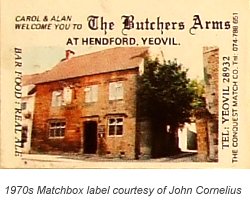 The
advertisement
below, from
Whitby's Yeovil
Almanack
Advertiser of
1885, offers hot roast
beef with
vegetables for
6d on Tuesdays,
with the same on
Fridays plus
mouth-watering
hot tripe and
vegetables for
the grand sum of
4d.
The
advertisement
below, from
Whitby's Yeovil
Almanack
Advertiser of
1885, offers hot roast
beef with
vegetables for
6d on Tuesdays,
with the same on
Fridays plus
mouth-watering
hot tripe and
vegetables for
the grand sum of
4d.
Note too that it offered "a select room for farmers, etc." being a hangover from the old Market Day 'Ordinary' - a set meal around a communal table.
By the 1890s the Butchers Arms was a tied house of the Royal Osborne Brewery, owned by Earle Vincent. When Vincent died in 1893 his estate was sold off the following year which included "the Butchers' Arms Inn, in Hendford, let at £32 a year (about £3,200 at today's value)."
In the Yeovil Guide of 1962 the Manor Hotel and the Mermaid Hotel were the most expensive hotels in Yeovil with Bed and Breakfast from 25/- per night (about £48 at today's value). For comparison the Three Choughs Hotel was 22/6 per night, the Pen Mill Hotel was 16/-, the Elephant & Castle Hotel was 15/6 and the Globe & Crown was cheapest at 14/6 (about £13.50 at today's value). By 1970 the prices were still the most expensive at the Manor Hotel with Bed & Breakfast from 45/- to 55/- per night (£50 to £63 at today's value), lunch at 14/6 (about £19) and dinner at 16/6 (about £22). Again for comparison, Bed & Breakfast at the Three Choughs Hotel was 42/- per night with breakfast only at 9/6 and tea from 3/6, the Preston Hotel was from 32/6 per night with lunch at 12/6 and dinner from 14/6, the Butchers Arms was 25/- for a single and 45/- for a double room per night and the Elephant & Castle Hotel was cheapest at 21/6 (about £29) per night.
The Butchers Arms must be the only Yeovil pub still with an outside toilet for the gents.
![]()
The first recorded licensee, George Raymond, was born about 1794 at Queen Camel, seven miles northeast of Yeovil. George had been licensee of the White Hart in Stars Lane in 1828 and 1830 which, at the time, was owned by Thomas Cave the brewer of Hendford. George was also listed as a shopkeeper and bacon and cheese factor. Interestingly in the 1840 Somerset Gazette Directory he is also listed as a brewer making him one of only two or three beerhouse keepers actually known to have taken advantage of the brewing part of the Beerhouse Act 1830. Or was he? The 1841 census also lists him as a brewer, living in the same house in Hendford as the commercial brewer Edmund Henning. It may be, therefore, that George Raymond was running what would effectively have been the brewery tap for Henning's brewery. In 1841 George was living with his wife, Mary, and their 14-year old son, George. By 1851 Henning had gone and George gave his occupation as inn keeper and his son George was listed as his assistant. By 1861 George and Mary were living in South Street where George, now aged 66, gave his occupation as cheese dealer etc. By 1871 George and Mary were living in Thomas' Yard off Kingston where George described his occupation as dealer in cheese, malt & hops. By 1881 George had finally retired and, somewhat surprisingly, gave his occupation as retired publican. He and Mary were still living in Kingston but Mary died in the summer of 1881 and George died in the summer of 1883.
The next licensee, John Slade, was born around 1810 in Stoke sub Hamdon. He had been the licensee of the White Hart Inn (later Duke of Clarence) in Stars Lane in 1842 with his wife, Jane. They were running the Butchers Arms by 1859 and in the 1861 census there was a seven-strong family of boarders living in the pub with them. (There were seven men called John Slade in Yeovil in 1861). John was still licensee in 1866 but by 1871 he was running the Lamb Inn in Back Kingston. John died in 1872 aged 64.
The next licensee, Caius Marius Templeman, was born around 1810 in East Chinnock. He was a career soldier and in the 1861 census he was listed as a Sergeant of Royal Marines on board HMS Liffey which, at the time of the census, was moored in the Grand Harbour at Malta. The Liffey had been commissioned in 1856 and was a 51-gun frigate with a ship's complement of 545. There had, apparently, been an incident on board that Caius would undoubtedly have witnessed that caused the crew to release cannon balls on deck - shot rolling in the days of sail was a method used by the ship's company to show deep dissatisfaction with the state of affairs on board. Such an unhappy ship was sometimes referred to as a "shot-rolling ship". It may have been connected with the incident of 11 Mar 1861 at Valetta, where a fresh case of Smallpox was reported on board. By 1871 Caius had returned from sea, retired from the Marines and was licensee of the Butchers Arms which he ran with his wife, Harriett. In the 1871 census Caius and Harriett were still at the Butchers Arms and, boarding with them, John Saunders and his small family - a fellow Sergeant of Royal Marines. Caius died in 1895.
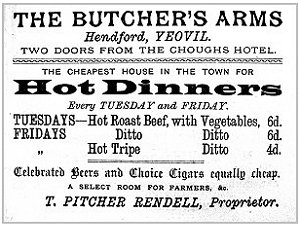 T Pitcher
Rendell was the
next licensee
but is only
known from a
single
advertisement in
Whitby's 1885
Yeovil Almanack
Advertiser.
T Pitcher
Rendell was the
next licensee
but is only
known from a
single
advertisement in
Whitby's 1885
Yeovil Almanack
Advertiser.
He was followed by Lazarus Burt who was born in Hardington Mandeville around 1835 and had been raised by his grandparents. By 1851 he was an agricultural labourer, aged 14. In 1858 he married Elizabeth and they had a baby son, Charles. By 1861 they still lived in Hardington and Lazarus was now a railway porter, but within ten years their family had expanded to four sons and Lazarus was back working on the land as an agricultural labourer once again. Add another ten years and the only difference to the family's condition was a daughter, Emily. Elizabeth died in 1884 and in 1885 he married Caroline. In 1891 he was licensee of the Butchers Arms where he lived with Caroline, a general servant and a stable boy. There was also one boarder. Sadly, Caroline died in late 1891. By 1894 Lazarus had moved on from the Butchers Arms but he remarried in the spring of 1897 to Sarah. By the time of the 1901 census they were living at Rustywell where Lazarus was described as 'living on own means'. Lazarus died in 1906.
William Sansom was born in Sherborne, Dorset around 1868, the son of John Sansom, a mason's labourer, and his wife Eliza. By 1891 William was aged 23 and was running the Cross Keys Inn in Park Street where he was listed as a baker and lived with his wife, Alice, and their baby son, William. By 1894 William was licensee of the Butchers Arms, where he stayed for only a couple of years and by 1901 William and his family were living in Wareham, Dorset, where he had returned to his old profession of bread maker.
The next licensee, Charles Parsons of Milborne Port, was primarily a glover and only seems to have played at being a licensee. In 1881 he was described as a leather parer and lived at 5 Reckleford with his wife, Augusta, and three children. Very little changed in the next ten years apart from the birth of another son. In 1897 he was listed as a beer seller in Kelly's Directory and in the 1901 census, although he and his family were occupying the Butchers Arms, he was again listed as a glove leather parer.
William S Hardy was born about 1866 in Yeovil was the son of farmer George Hardy and his wife, Ann. In 1871 the family lived in East Lydford, some 13 miles to the north of Yeovil. By 1881 Ann had died and the family moved to Yeovil where George was employed as a commercial traveller for one of the breweries while 15-year old William was unemployed. During the next decade William married and by the 1891 census he was living with his wife, Annie, and their two baby sons at 48 Queen Street. William's occupation was given as a wine and spirit cellarman and Annie was a glover. Ten years later and William and Annie now had five young boys and were living in Camborne Grove. William was still a wine merchant's cellarman, however by 1911 he was the manager of the Castle Hotel and Annie was the manageress. By 1916 William was licensee of the Butchers Arms.
gallery
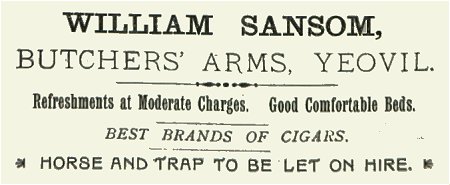
An advertisement for William Sansom's Butchers' Arms from the 1894 edition of the Western Gazette Almanac.
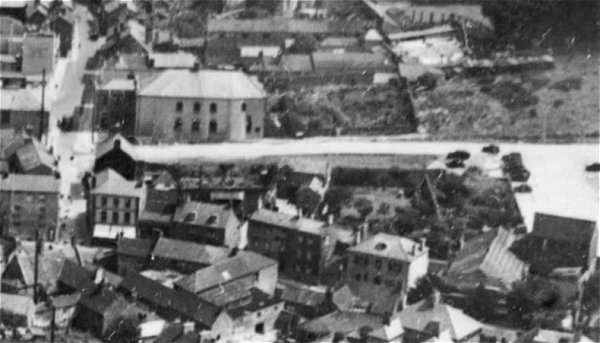
This aerial photograph dates to 1935 and shows Petters Way running across the photograph from South Street, at left, to the car park at right. Buildings of note are - the Greyhound Inn at very top left, the Baptist church at top left, the Three Choughs Hotel at centre left edge with the junction of South Street with Hendford to its right. On the opposite corner the buildings running along the east side of Hendford (with their street elevations facing us) are Chudleigh's seed merchants, the small shop that had been John Chaffin's photographic studio (later the WI Market), next to the Butcher's Arms. Next is Flower's House then Ayr Villa and finally the furniture emporium known as The Rink owned by Henry White. Note that in the top right hand corner is the field that the Yeovil Law Courts and Police Station would be built on three years later, in 1938.
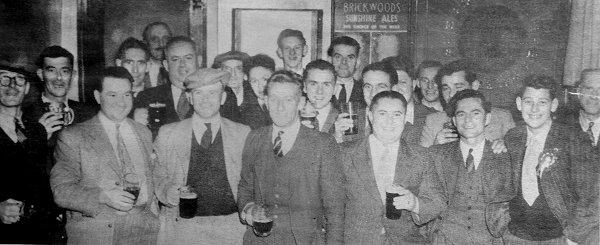
'Regulars' of the Butchers Arms having a quick pint before going on an outing in 1947.
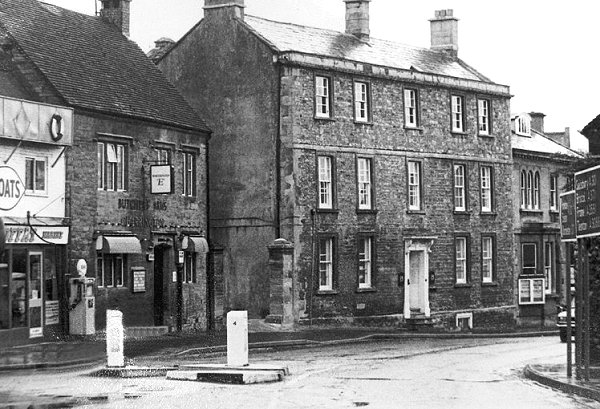
This photograph
features in my
book 'Yeovil
From Old
Photographs'.
The Butchers Arms photographed about 1970, before Moffat Marine was demolished for road widening.
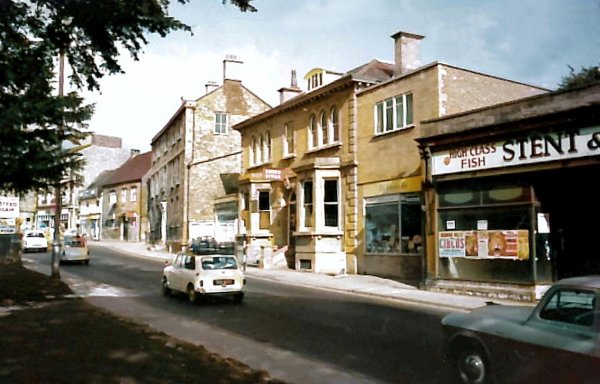
This colourised photograph, taken about the same time as the previous shot, but looking along Hendford towards the Butcher's Arms. The fish shop has gone, its site now occupied by Dolphin House, but all of the other buildings, including Ayr House at centre with the double bay windows and Flower's House next to it, remain today up to, and including, the Butcher's Arms seen between the two cars.
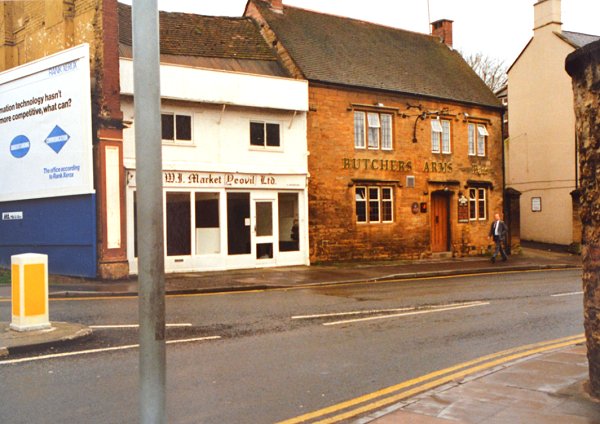
Courtesy of
Chris Rendell
The Butchers Arms photographed in 1989.
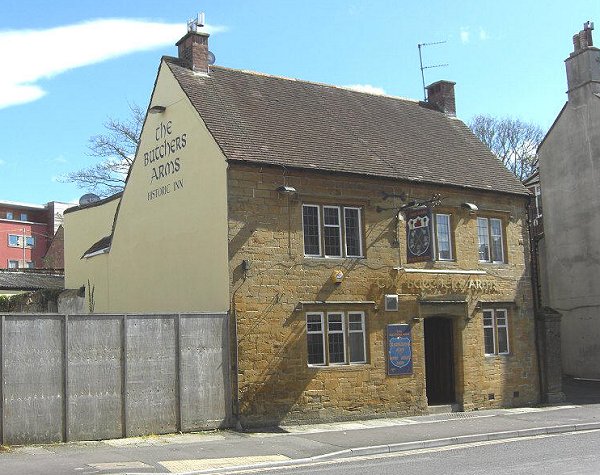
The Butchers Arms, photographed in 2012.
![]()
The following details are from the sale brochure when the Butchers Arms was for sale in 2009..
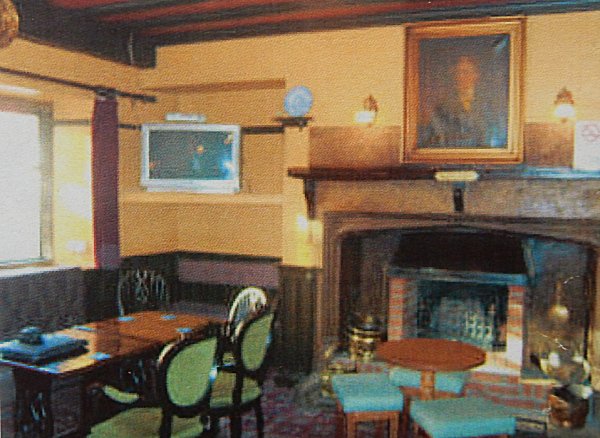
From my
collection
The front bar. I'm sure the wooden mantelpiece over the fire isn't as straight as in the photo!
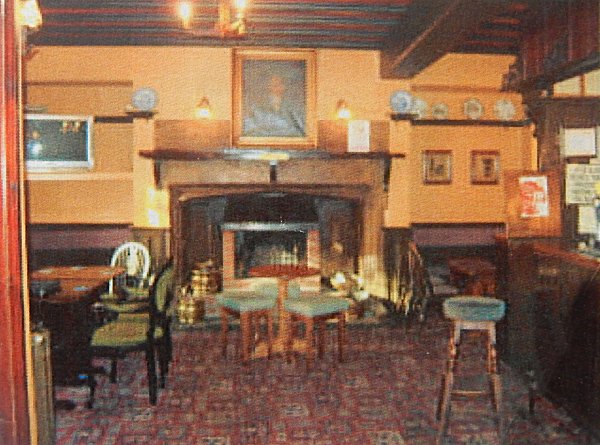
From my
collection
The front bar from a different angle. The beamed ceiling is not as old as it looks.
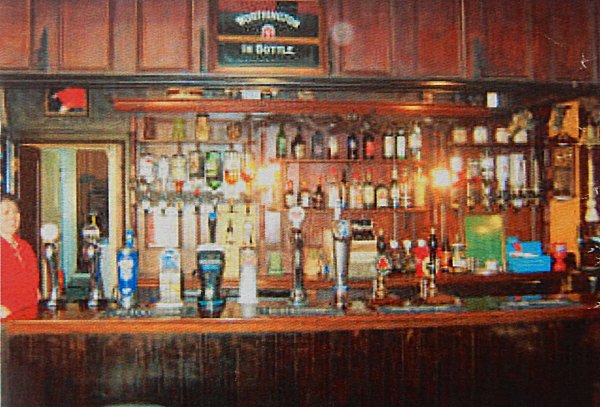
From my
collection
The front bar servery.
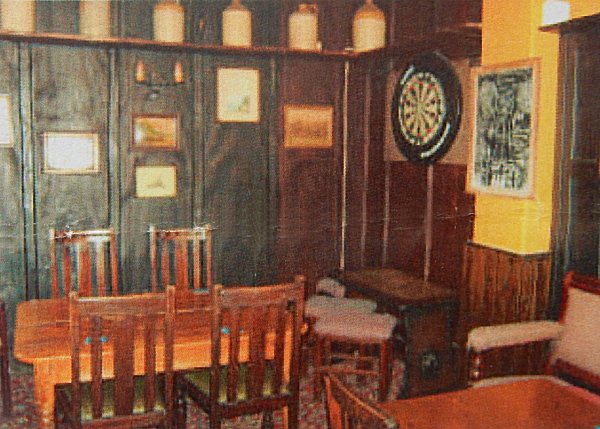
From my
collection
The side bar.
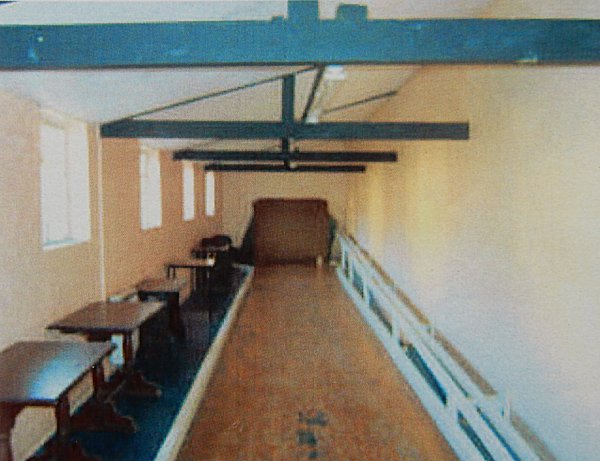
From my
collection
The skittle alley.
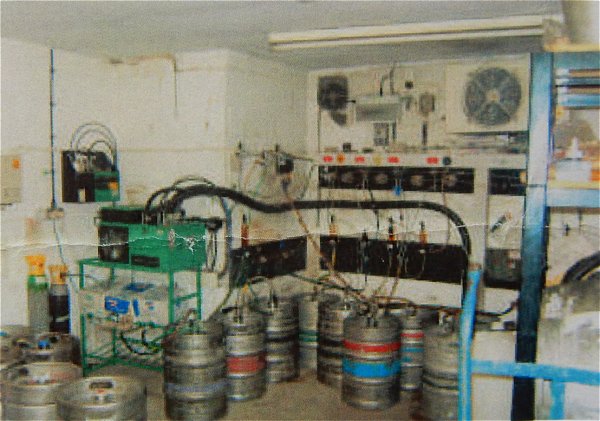
From my
collection
The cellar.
The 2009 sale details of this cracking little pub cleverly omit to mention the pub's star feature of the only outside gent's toilet in Yeovil (and even more cleverly omitted to photograph it) but the details offer some interesting notes, as follows -
|
Lounge Bar |
A good sized locals bar area with lots of character and an open stone fire. Darts board but no teams at present. |
|
Kitchen |
A small but adequate kitchen situated behind the bar. There is no catering at present but in our opinion this should be an important part of the business. |
|
Skittle Alley |
There are 5 skittle teams and the possibility of also using this area as a meeting room. |
|
Cellar |
Ground floor well equipped cellar. |
|
External |
Enclosed patio area that also serves as a smoking area. Private car parking. |
|
Private |
3 bedrooms, office, lounge. |
licensees
1839 – George
Raymond – Beer
Retailer
(Robson’s 1839
Directory)
1840 – George
Raymond – Brewer
(1840 Somerset
Gazette
Directory)
1841 – George
Raymond – Brewer
(1841 census)
pub not named
but in Hendford
1842 – George
Raymond –
Retailer of Beer
(Pigot’s 1842-4
Directory)
1850 – George
Raymond – Beer
Retailer (Hunt &
Co's 1850
Directory)
listed in
Hendford
1851 – George
Raymond – Inn
Keeper (1851
census) pub not
named but at 28
Hendford Street
1852 – George
Raymond –
Retailer of Beer
(Slater's 1852/3
Directory)
1859 – John
Slade (Harrison,
Harrod & Co 1859
Directory)
listed as
Butchers' Arms,
Hendford.
1861 – John
Slade – Butcher
& Beerhouse
Keeper (1861
census)
1866 – John
Slade – Beer
Retailer
(Kelly's 1866
Directory)
1866 – John
Slade – Beer
Retailer (1866
Post Office
Directory)
1868 – Caius
Templeman –
Fined for
out-of-hours
drinking (Petty
Sessions,
September)
1871 – Caius
Templeman –
Publican (1871
census) listed
as Butchers Arms
1872 – Caius
Templeman – Beer
Retailer
(Kelly's 1872
Directory)
1875 – Caius
Marius Templeman
–Beer Retailer
(1875 Post
Office
Directory)
1875 – Caius
Marius Templeman
– Beer Retailer
(Kelly's 1875
Directory)
1881 – Caius
Templeman –
Publican (1881
census) listed
as Butchers Arms
1885 – T Pitcher
Rendell -
Proprietor
(Whitby's Yeovil
Almanack
Advertiser 1885)
1891 – Lazarus
Burt – Beerhouse
Keeper (1981
census) listed
as Butchers Arms
1892 – Lazarus
Burt - License
transfer
(Borough Petty
Sessions,
January)
1892 – William
Sampson -
License
transferred
(Borough Petty
Sessions,
January)
1894 – William
Sansom (Western
Gazette 1894
Almanac)
1895 – William
Sanson – Beer
Retailer
(Kelly’s 1895
Directory) pub
not named
1897 – Charles
Parsons – Beer
Seller (Kelly’s
1897 Directory)
1901 – Charles
Parsons, Glove
Leather Parer
(1901 census)
1903 – Eli
Jennings
(Whitby's Yeovil
Almanack
Advertiser 1903)
1911 – Mr Baker
(1911 census
Summary)
1914 – George
Baker – Beer
Retailer
(Kelly’s 1914
Directory) pub
not named
1916 – William S
Hardy (Whitby's
Yeovil Almanack
Advertiser 1916)
1917 – Albert D
Aspell "of the
Butcher's Arms"
- fined for
light out on car (Petty
Sessions)
1919 – Mrs Annie
Gumb (Kelly’s
1919 Directory -
Beer Retailers)
1923 – Annie
Gumb – Beer
Retailer
(Kelly’s 1923
Directory) pub
not named
1938 – AE Gumb
(1938 Yeovil
Directory)
listed as
Butchers Arms
1939 – William
Rogers (Kelly’s
1939 Directory)
listed as
Butchers Arms
1949 – W
Rogers (Kelly’s
1949 Directory)
listed as
Butchers Arms
1954 – W Rogers
(1949 Yeovil
Directory)
2008 – Carol
White (Western
Gazette article)
2010 – Guy
Reynolds
(Western Gazette
article)